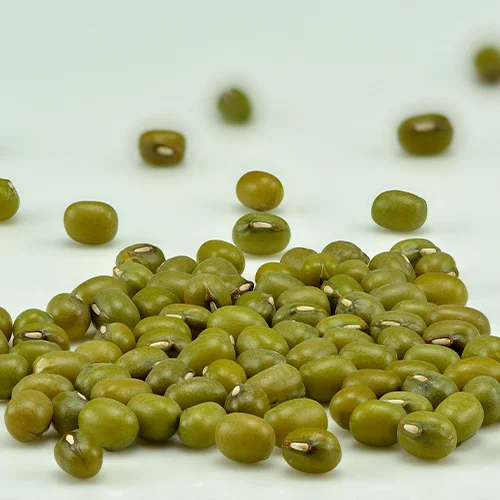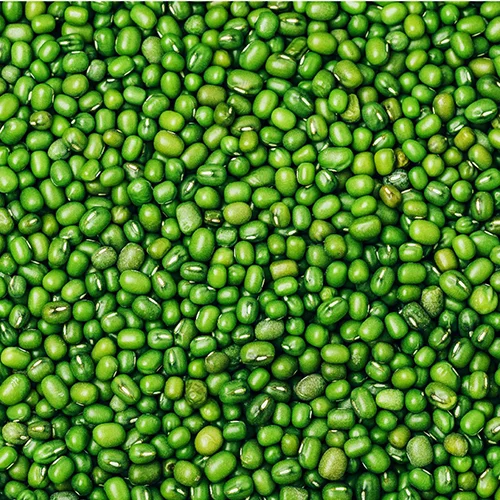Mungo



Quick inquiry
Product Description
Botanical Name – Vigna radiata
Origin – India and Central Asia
Synonym – Moong
HS Code – 07133100
The mung bean or green gram (Vigna radiata) is a plant species in the legume family.The mung bean is mainly cultivated in East, Southeast and South Asia. It is used as an ingredient in both savoury and sweet dishes.It is also known in Philippine English as “mongo bean”.Other less common English names include “golden gram” and “Jerusalem pea”.
Mung bean (Vigna radiata) is a plant species of Fabaceae and is also known as green gram. The green gram is an annual vine with yellow flowers and fuzzy brown pods. There are three subgroups of Vigna radiata, including one cultivated (Vigna radiata subsp. radiata) and two wild ones (Vigna radiata subsp. sublobata and Vigna radiata subsp. glabra). It has a height of about 15–125 cm (5.9–49.2 in).
Mung beans are one of many species moved from the genus Phaseolus to Vigna in the 1970s. The previous names were Phaseolus aureus or P. radiatus.
Mung bean plants have a long history of being consumed by humans. The main consumed parts are the seeds and sprouts. The mature seeds provide an invaluable source of digestible protein for humans in places where meat is lacking or where people are mostly vegetarian. Mung bean has a large market in Asia (India, Southeast Asia and East Asia) and is also consumed in Southern Europe and in the Southern US. Mung bean protein is considered safe as a novel food (NF) pursuant to Regulation (EU) 2015/2283.The consumption of mung bean varies depending on the geographic region.
For instance, in India, mung bean is used in sweets, snacks and savoury items. In other parts of Asia, it is used in cakes, sprouts, noodles and soups. In Europe and America, it is mainly used as fresh bean sprouts. The consumption of mung beans as such in the US is in the order of 22–29 g/capita per year,while the consumption in some areas of Asia can be as high as 2 kg/capita per year.
East Asia:
In southern Chinese cuisine, whole mung beans are used to make a tángshui, or dessert, called ludòu tángshui, which is served either warm or chilled. They are also often cooked with rice to make congee. Unlike in South Asia, whole mung beans seldom appear in savory dishes.
In Hong Kong, hulled mung beans and mung bean paste are made into ice cream or frozen ice pops. Mung bean paste is used as a common filling for Chinese mooncakes in East China and Taiwan. During the Dragon Boat Festival, the boiled and shelled beans are used as filling in zongzi prepared for consumption. The beans may also be cooked until soft, blended into a liquid, sweetened, and served as a beverage, popular in many parts of China. In South China and Vietnam, mung bean paste may be mixed with sugar, fat, and fruits or spices to make pastries, such as bánh d?u xanh.
In Korea, skinned mung beans are soaked and ground with some water to make a thick batter. This is used as a basis for the Korean pancakes called bindae-tteok. They are also commonly used for Hobak-tteok.
Southeast Asia
In the Philippines, ginisáng monggó/mónggo (sautéed mung bean stew), also known as monggó/mónggo guisado or balatong, is a savoury stew of whole mung beans with prawns or fish. It is traditionally served on Fridays of Lent, when the majority of Catholic Filipinos traditionally abstain from meat. Variants of ginisáng monggó/mónggo may also be made with chicken or pork. Mung beans are also used in the Filipino dessert ginataang munggo (also known as balatong), a rice gruel with coconut milk and sugar flavored with pandan leaves or vanilla.
In Korea, slightly cooked mung bean sprouts, called sukjunamul (Korean: ????), are often served as a side dish. They are blanched (placed into boiling water for less than a minute), immediately cooled in cold water, and mixed with sesame oil, garlic, salt, and often other ingredients.
In the Philippines, mung bean sprouts are called togue and are most commonly used in lumpia rolls called lumpiang togue.
In India, mung bean sprouts are cooked with green chili, garlic, and other spices.
In Indonesia the food are often used as fillings like tahu isi (stuffed tofu) and complementary ingredient in many dishes such as rawon and soto.
In Japan, the sprouts are called moyashi.
Moong can be used as a feed for cattle even husk of the seed can be soaked in water and used as cattle feed.They’re high in nutrients and believed to aid many ailments.
One cup (7 ounces or 202 grams) of boiled mung beans contains (3):
– Calories: 212
– Fat: 0.8 grams
– Protein: 14.2 grams
– Carbs: 38.7 grams
– Fiber: 15.4 grams
– Folate (B9): 80% of the Reference Daily Intake (RDI)
– Manganese: 30% of the RDI
– Magnesium: 24% of the RDI
– Vitamin B1: 22% of the RDI
– Phosphorus: 20% of the RDI
– Iron: 16% of the RDI
– Copper: 16% of the RDI
– Potassium: 15% of the RDI
– Zinc: 11% of the RDI
– Vitamins B2, B3, B5, B6 and selenium
Mung beans are one of the best plant-based sources of protein. They’re rich in essential amino acids, antioxidants, and nutrients that may help reduce blood pressure, LDL cholesterol levels, and heart disease risk.
Impressive Health Benefits of Mung Beans:
– Mung beans are high in important vitamins, minerals, protein and fiber. Sprouted mung beans contain fewer calories but have more antioxidants and amino acids.
– Mung beans are a good source of antioxidants, which may reduce your risk of chronic diseases, such as heart disease, diabetes and certain cancers. However, more human-based research is needed before making health recommendations.
– Mung beans contain antioxidants such as vitexin and isovitexin that may protect against free radical damage that occurs during heat stroke.
– Animal studies have shown that mung bean antioxidants may lower “bad” LDL cholesterol, while human studies have linked higher legume consumption to lower LDL cholesterol levels.
– Mung beans are a good source of potassium, magnesium and fiber, which have been linked to lower blood pressure levels in adults with and without high blood pressure.
– Mung beans contain soluble fiber and resistant starch, which can promote digestive health. The carbs in mung beans are also less likely to cause flatulence than those of other legumes.
– Mung beans are high in fiber and protein and contain antioxidants that may lower blood sugar levels and help insulin work more effectively.
– Mung beans are high in fiber and protein, which can help curb hunger by lowering levels of hunger hormones, such as ghrelin, and raising fullness hormones, such as peptide YY, GLP-1 and cholecystokinin.
– Mung beans are high in folate, iron and protein, all of which women need more of during pregnancy. Avoid raw mung bean sprouts when you’re pregnant, as they may contain harmful bacteria.
– Mung beans are versatile and easy to add to your diet. The beans are often boiled or steamed, while sprouts are commonly enjoyed either raw or cooked in stir-fry meals.
